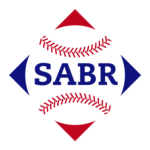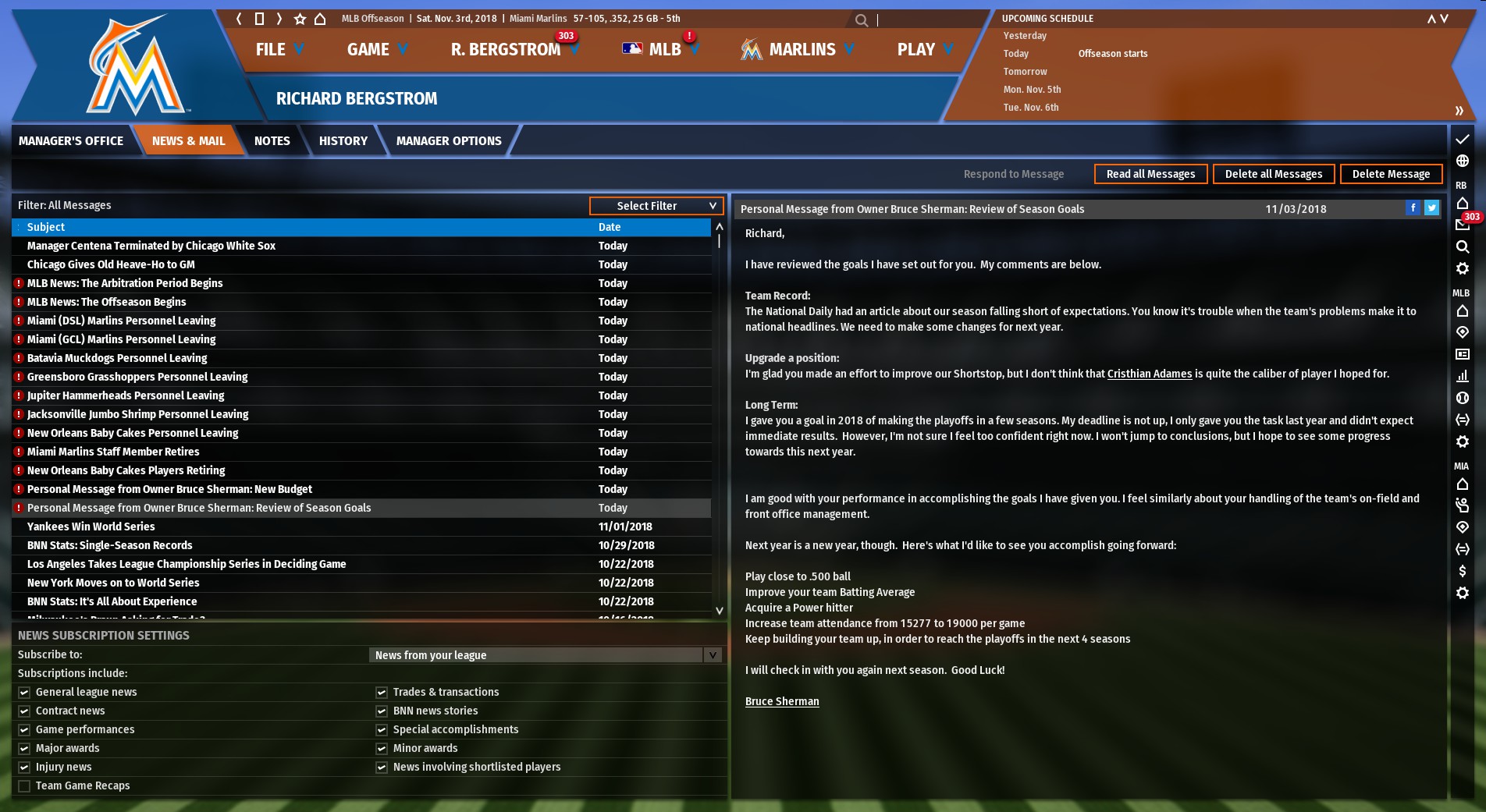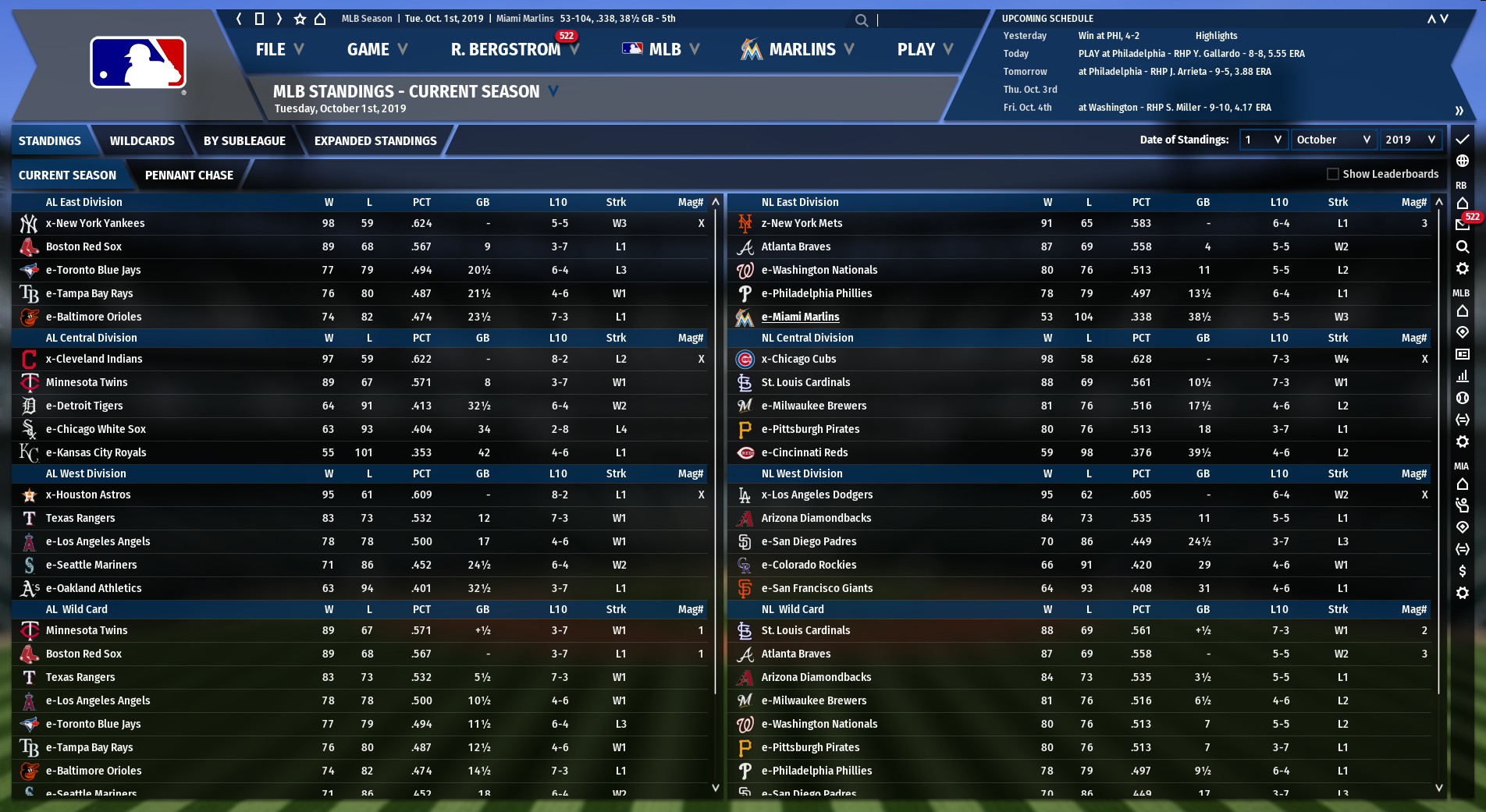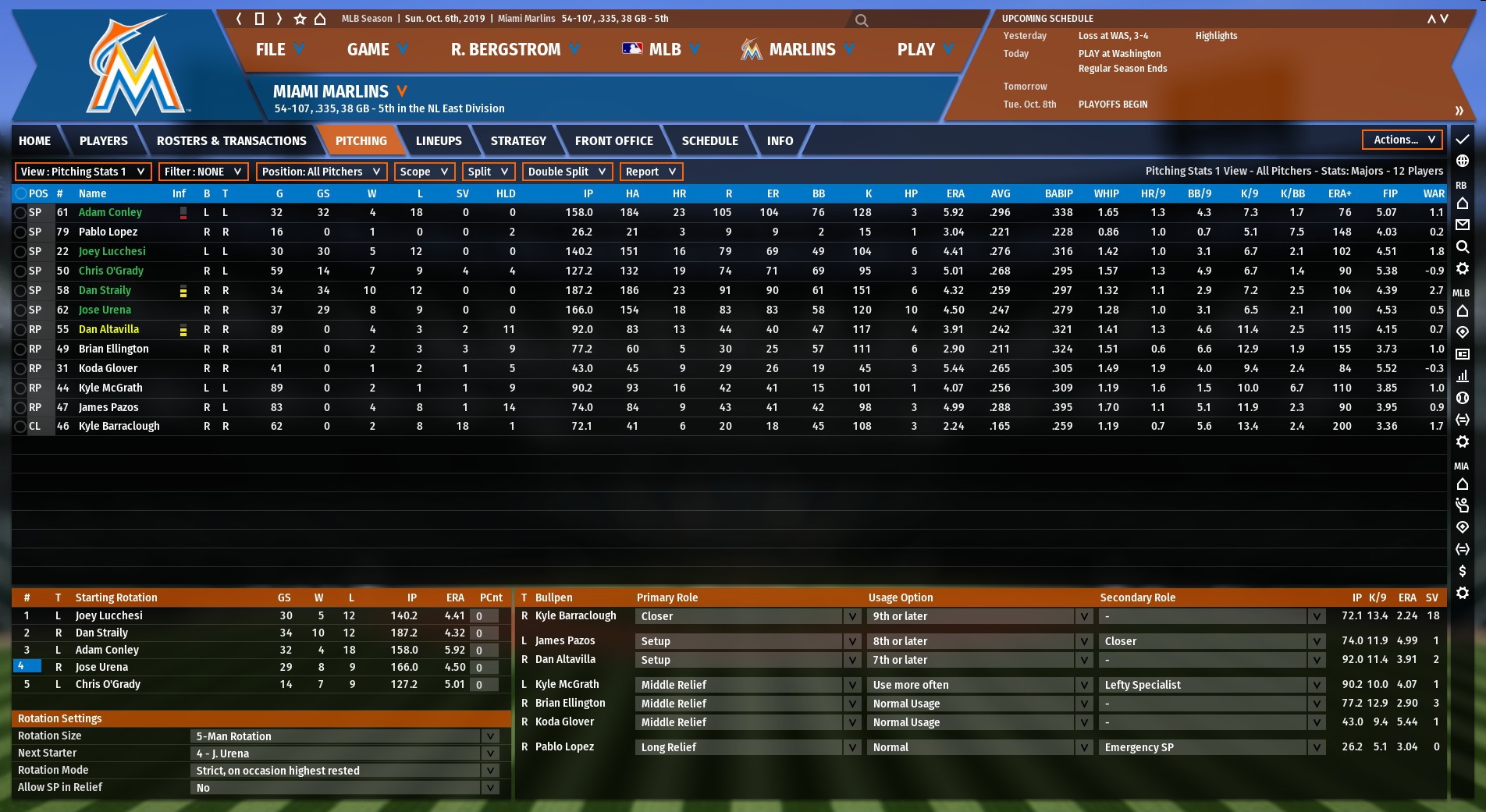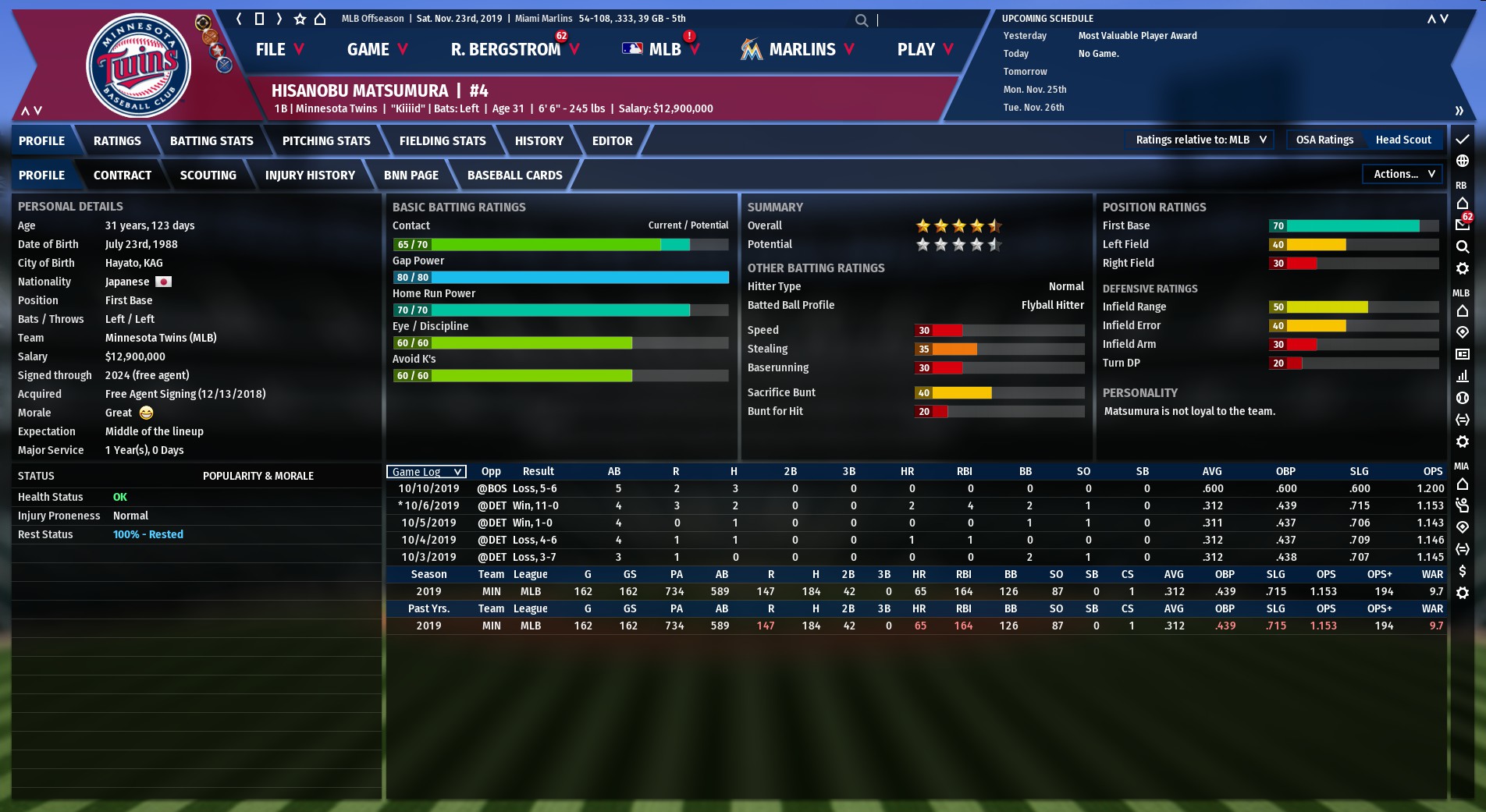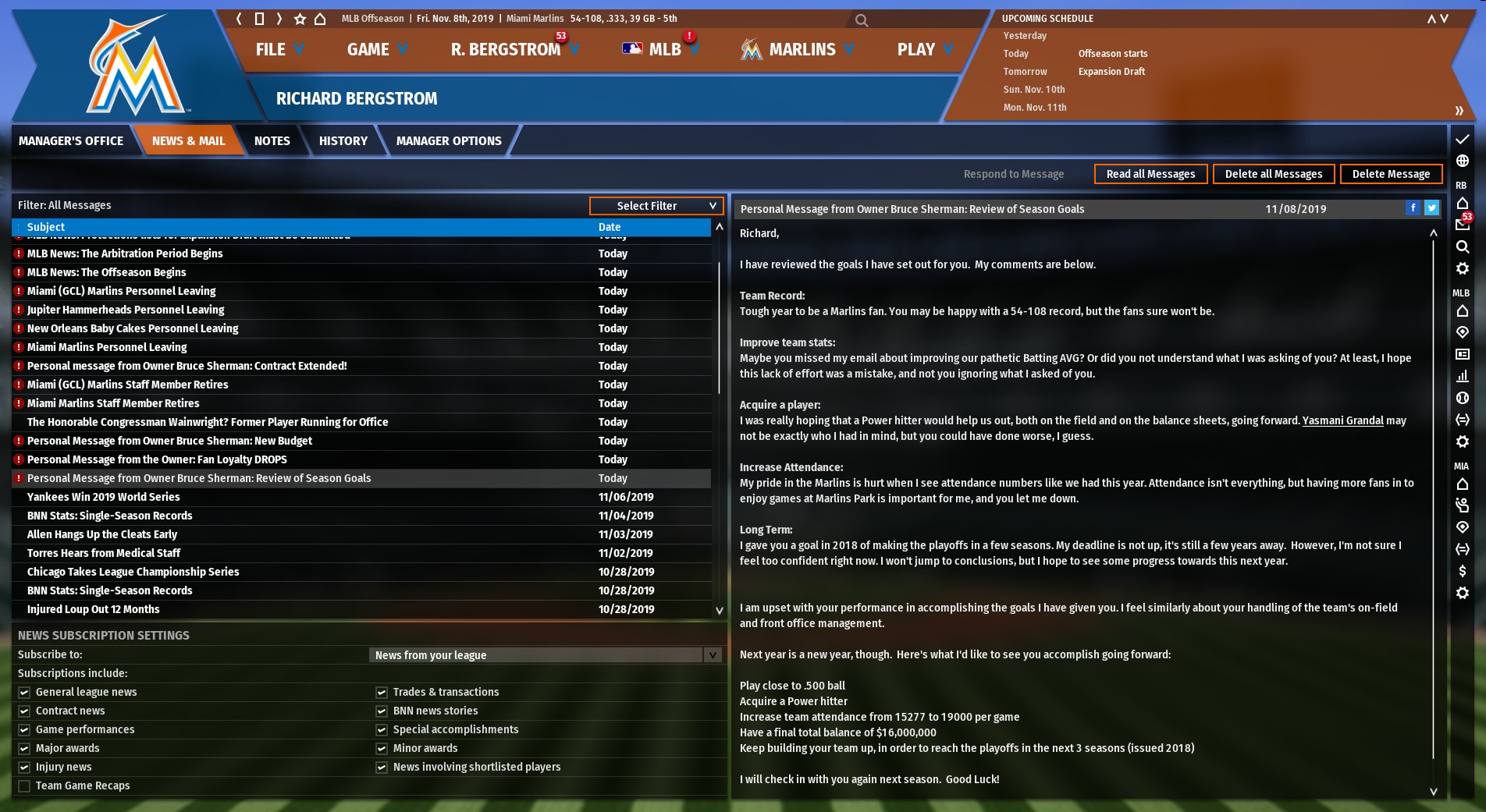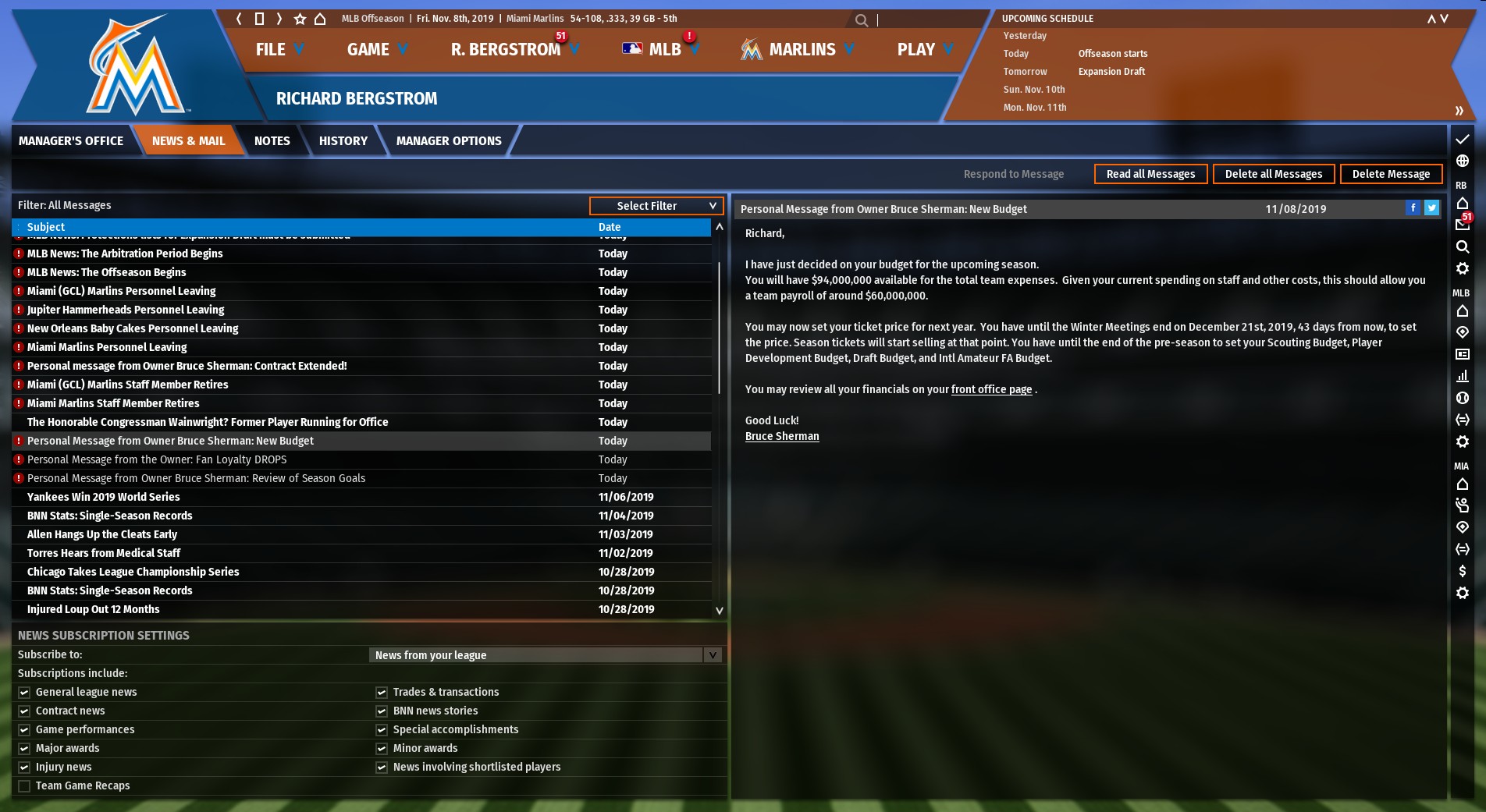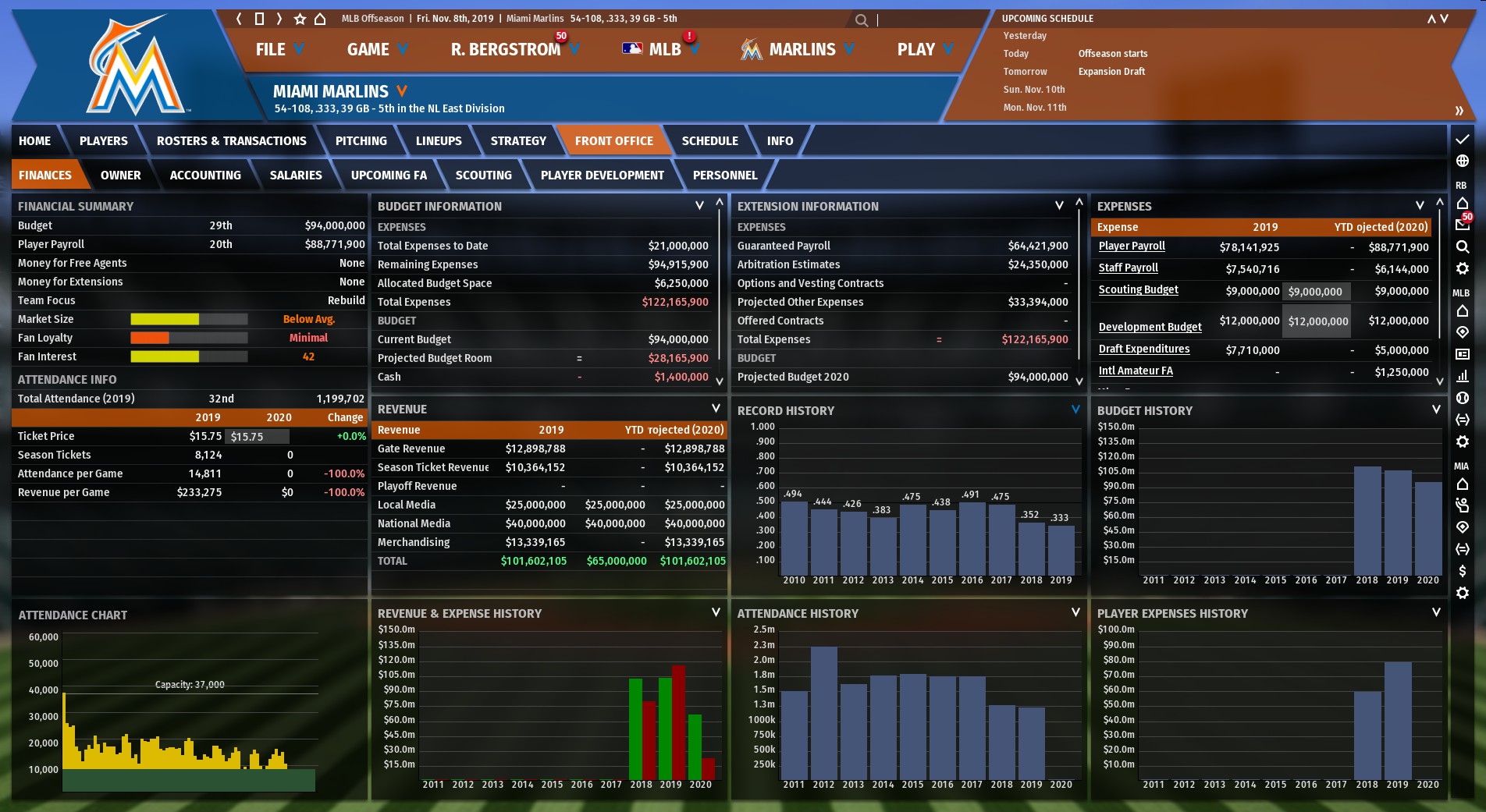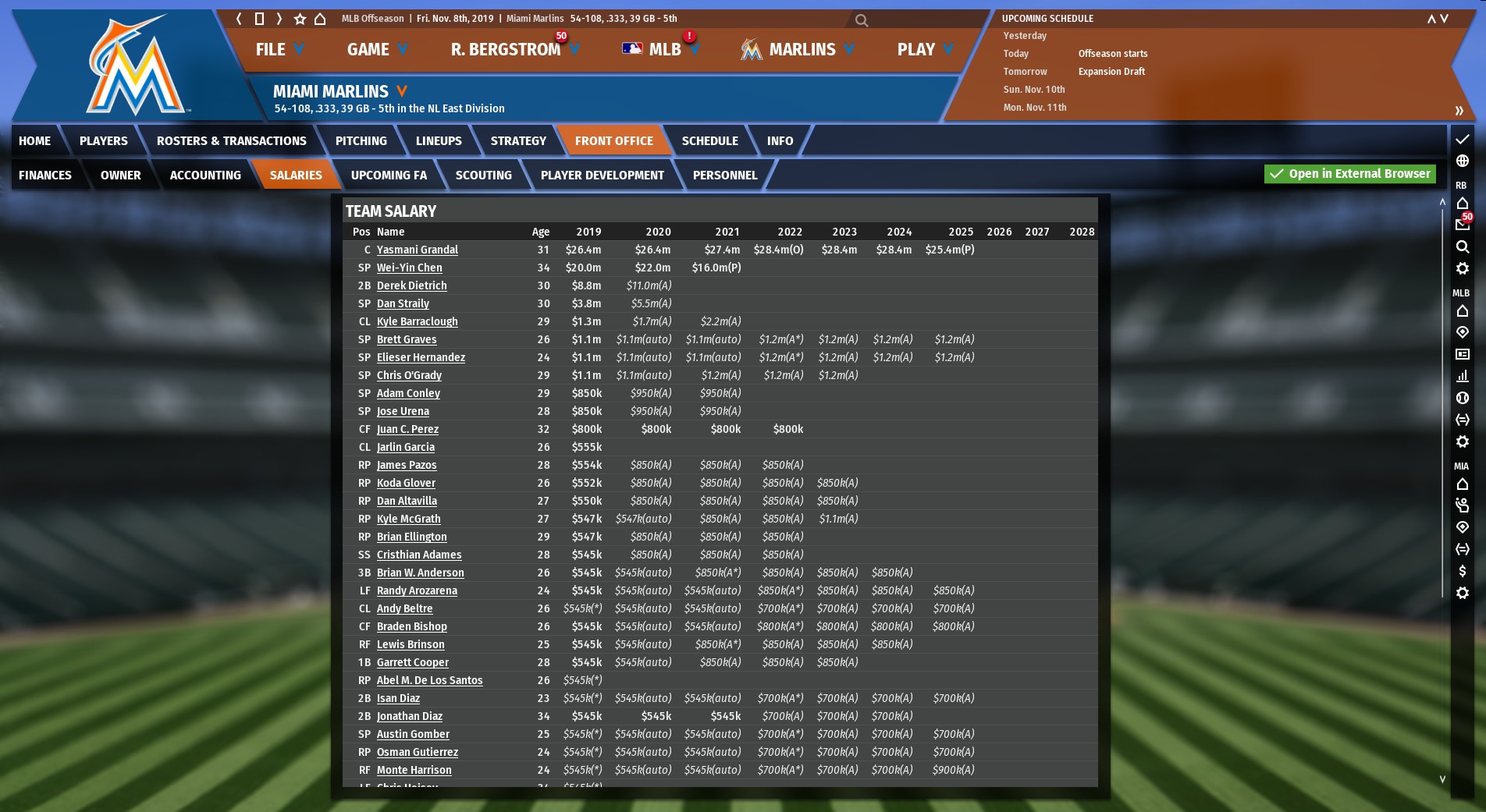Last week, I decided to kick off this year’s edition of Out Of The Park Baseball (OOTP), a baseball computer simulation game available via Steam, by trying to turn the Miami Marlins into a winner. I’m trying my best to play the game with realism i.e. not game the system’s artificial intelligence too much, even though the team really sucks. Recapping the 2018 season playthrough, the team stumbled to a 57-105 record, which was better than some of the test simulations I did but not by much. The offense was led by Starlin Castro and, um, the pitching wasn’t really led by anyone but the rebuilt bullpen showed some promise and the pitching staff with the exception of Wei-Yen Chen was dirt cheap.
With a new year comes a new set of goals. I got a chuckle about Mr. Sherman wanting me to increase attendance by 25% but apparently there’s no way to counteroffer with a demand to get the 2017 Marlins outfield back. After last season’s showing and given that any talent I have is still around A ball, I’m not sure .500 ball is feasible either. However, improving the team batting average and getting a power hitter should be doable, given that I have about $30 million in budget flexibility.
I took a peek at the free agent market and the international market and immediately hit a free agent dilemma. I could go with catcher Yasmani Grandal who had a 75 defensive rating, hopefully enough power to pass the “Acquire a Power hitter” with a capital P goal, and would help me in the on-base department. I’ve also played OOTP for quite a few years and Grandal usually plays well for me if I get him. The downer was that he was demanding about $27 million a year for seven years. I probably would be ok if I kept my current catchers with their defensive focus, but the margin was really thin and I seriously needed an upgrade on offense.
Or, I could go with international free agent first baseman Hisanobu Matsumara…
If I have one pet peeve about OOTP, it is that the top international free agents are unrealistic in that they are usually too good for too cheap of a price compared to their MLB brethren. Matsumara was listed with 80s in contact, home run power and discipline with an 80 glove. His asking price was $14 million, half the price of Grandal and a third of the price of Bryce Harper. Generally once you sign an international player, their stats drop a tad but the dude looked like a stud. The trick is I had Justin Bour at the major league level and a bevy of first base prospects led by Sam Travis raking at AAA. On top of that, I wanted to stay realistic. Given MLB’s posting system, I didn’t think there was any way a real life Matsumara would choose the Marlins. Otherwise I would have swept him up in a heartbeat, but grudgingly, I let him pass and negotiated Grandal down to a 7 year contract at $190 million. Burp, ‘cuse me that was a lot of cash. Though I negotiated him down to get a little savings, I also gave him an opt-out
I sent last year’s starting catcher, Tomas Telis, off to the Astros for three older (25-29 years of age), two star players. Two of them were first baseman that could hit and draw a walk. One of them was a second baseman. None of them might pan out but they could help in the short term. I picked up Chase Vallot from the Rule 5 Draft to back up Grandal. He was a bit below the catching defense standards I usually have, clocking in at a 40 rating, but his bat seemed major league playable.
Even though Castro was one of my better players on offense, it was with just a .715 OPS at a cost of $10 million. If he could play shortstop decent, I might’ve kept him around, but I had a few second base options I wanted to try out along with Max Schrock, acquired in the Rick Porcello debacle, working his way up through the minors. So, during the offseason, I sent Castro, along with relief pitchers Dustin Beggs and Braxton Garrett to the Los Angeles Angels of Anaheim for a set of two star prospects in center fielder Michael Hermosillo, catcher Taylor Ward and starter Cole Duensing. Duensing looked promising as a 22 year old starter with a sub-2.00 ERA and a K/9 around 8 and since he was so young, he had some time to cook.
The weakest member of my bullpen was Nick Wittgren who, thanks to a bit of BABIP help, was able to provide results despite a K/9 rate of 5.7. He became a Cub for two two-star relievers with the fringe benefit that I had freed up a slot on my 40 man roster.
Since the first season started the timeline just a few days before Opening Day, my organization was still very thing. I worked to remedy that by signing a whole bunch of minor league free agents to give my organization some depth. Anyone who had 55 or better defense at shortstop or center field and could play multiple positions, anyone who caught at a 70 or better, and anyone who was at least 50s across the board as a starting pitcher became mine. With all of my moves for the 2019 done, I crossed my fingers and my toes and advanced towards, then through Opening Day.
Generally when I run a simulation, I automate baseball games for a week at a time, checking on the lineup and pitching staff to see if there’s anything extreme going on. I try to be patient with hitters who get off to slow starts if they have a track record of success. By mid-May, I was bored of Justin Bour. He had a .226/.284/.427 OPS, “good” for a .711 OPS. I thought Travis could top that and for much less than Bour’s contract of $3.8 million. I traded him to the San Francisco Giants for Jonah Arenado because the roster salaries had been locked down for many of the teams which reduced my trading partners and the only way to accomplish a trade is by, you know, taking a player back.
The season overall was uneventful, mainly because the offense didn’t generate many events. Derek Dietrich continued to be useful, flitting between second base, third base and left field depending on who happened to be injured or disappointing. If you want the definition of quad-A players, look no further than Brian Anderson and Lewis Brinson, who consistently bounced between AAA and the majors without impressing at either location. I did get a five star prospect from the amateur draft, center fielder Sammy Siani, who looks like he’ll have a good glove and all around quality hitting skills despite being just 19. I made two trade deadline trades, sending away four older two-star players who would’ve been eligible for the next Rule 5 draft for younger two star players, but nothing real exciting. Yeah, in the end, this 2019 version of the Marlins was just as unexciting as the 2018 one, peaking around a .400 winning percentage before sinking farther.
54-108, three games worse than last year. Worst team in the league. Can’t say I blame them. Yet as we walk through the organization, the underpinnings are actually better than the previous year.
Grandal did his job, becoming the best hitter on the team with walks and power to boot. Lee’s .300 batting average helped bump his OBP to 381 and Sam Travis paid off my faith for him. Lat year, the team had only three players above a .300 OBP. This year it was up to 5. 2018, only one player had a WAR above 1. This team had four. I’m still stuck at shortstop preferring Cristhian Adames’s level of mediocrity to JT Riddle’s complete ineptitude. I’m still waiting for Brinson to hit since I can’t seem to find a better right fielder in the upper levels of the organization. Garrett Cooper, meanwhile, probably got ore at bats flipping between first base and the two corner outfield slots than he should have.
Dan Straily is the first ten game winner I’ve had. Yay. Small victories, right? My bullpen still did well and the starters with the exception of Conley did a touch better than in 2018 with mediocre but tolerable peripherals in terms of walks and strikeouts per 9. The staff gives up a lot of home runs though.. Wei-Yen Chen was a disappointment. Alternatively hurt and ineffective, he logged a 6.13 ERA through 113 innings. Such a poor use of $20 million, I should have pawned him off during the early, less expensive years of his contract. He’s virtually untradeable now. I’m not sure how I’m going to get out of that one…
On paper, ,well, computer paper anyways, this baseball team really is better than last year’s. The offense went from pathetic to well below average and the pitching is probably a tick below average. But the win-loss results just aren’t there.
Just for fun, here’s how Matsumara finished up.
I chose realism over a Triple Crown candidate. My bad. But hey, at least his stats dropped like I thought they would…
I’ve been fired as a general manager in OOTP, but it was a long time ago back when the owners really really wanted you to adhere to their goals. This is the first time I’m actually worried that I might be fired by the end of 2019. Drastic change has to happen without a lot of payroll room to do it. Hopefully that’ll help bump attendance too. But, even the future looks a little bleak. The farm system is still a mess, actually going down to 30th ranked out of 30 teams because Brinson and Anderson, the top two “prospects” in terms of Top 200 MLB ranking, graduated then sucked. Most of the quality is still around A ball. Some of those guys need to move quick because this team needs help.
To make matters worse…
Um… I have a math problem here…
Those cheap Marlins cut my budget for 2020 by $28 million! Silly computer game. All that payroll space I built up disappeared.
Not only that, but in order to make budget, I somehow not only have to get rid of Chen, but have to ditch my best player, Grandal, trim the scouting and draft pool budgets, switch from Smashburger to McDonalds… with all the trimming I had done, there’s very little else I can trim from! Only four players on the team make more than $1.5 million. Someone like Straily needs to throw those innings. Even if I ditch Dietrich instead of Grandal and somehow get rid of Chen, I’d still be over budget. A future payroll drop means I would’ve had to dump Grandal anyway.
What happens next? Will I get out of this and finally have a decent team? What happens when two new teams join the league because of expansion? Feel free to share your thoughts in the comments below and on Twitter about this installment and tune in next week, same fishy team, same fishy playthrough.
.
Originally from Chicago and after an extensive tour of most of the western United States, Richard has resided in Denver since 2004. He attends quite a few Rockies games, especially Rockies fireworks games! When not writing about baseball, he enjoys karaoke downtown, a bit of poker, and a bit too much of his iPad. His writing has appeared on ESPN.com, The Hardball Times, and Beyond the Box Score. He has also covered the Rockies as a credentialed writer as the founder of Rockies Zingers and as a writer for SBNation’s Purple Row.
- rwbergstromhttps://sabrbaseballgaming.com/author/rwbergstrom/
- rwbergstromhttps://sabrbaseballgaming.com/author/rwbergstrom/
- rwbergstromhttps://sabrbaseballgaming.com/author/rwbergstrom/
- rwbergstromhttps://sabrbaseballgaming.com/author/rwbergstrom/
